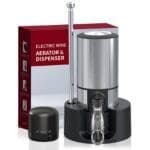This post may contain affiliate links. Please read my disclosure policy.
Barbera: The Unsung Heroine of Italian Vines
Introduction
Barbera (pronounced “Bar-bear-ah”), often the understudy in the grand theatre of Italian wines, is like the best-kept secret that everyone talks about but few truly know. This grape, with its vivacious charm and ruby red allure, might play second fiddle to the likes of Nebbiolo, but it’s the star in the hearts of those who cherish honest, hearty wines. Let’s stroll through the vineyards of Barbera – the wine that’s like your favourite aunt who always has the best stories and the warmest hugs.
Primary Flavours
Tasting Barbera is like taking a sensory tour through an Italian feast. It bursts with flavours of juicy cherries, ripe plums, and blackberries, accompanied by nuances of vanilla, anise, and sometimes a hint of smokiness. There’s an approachable, fruit-forward charm to Barbera, making it a crowd-pleaser among diverse palates.
Taste Profile
For Barbera, an Italian red grape known for its high acidity and lower tannins, producing wines with a bright and juicy character, here’s a table using wine glass icons for the ratings:
| Barbera | Barbera | Barbera |
|---|---|---|
| Aspect | Rating out of 5 | Characteristic |
| Sweetness | 🍷 | Typically dry, with a playful dance of ripe fruit flavors |
| Body | 🍷🍷🍷 | Medium-bodied, as versatile as an Italian opera singer |
| Tannins | 🍷🍷 | Moderately low, like a gentle whisper in a lively debate |
| Acidity | 🍷🍷🍷🍷 | Vibrantly high, like a burst of laughter in a trattoria |
| Alcohol by Volume | 🍷🍷🍷 | Generally around 13-14.5%, as warming as the Italian sun |
| Each wine glass icon 🍷 represents one point on a 5-point scale. Barbera is known for its lively acidity and juicy fruitiness, often featuring flavors of cherries, strawberries, and hints of spice. It's a popular choice for its food-friendly nature and is a staple in the Piedmont region of Italy. | Each wine glass icon 🍷 represents one point on a 5-point scale. Barbera is known for its lively acidity and juicy fruitiness, often featuring flavors of cherries, strawberries, and hints of spice. It's a popular choice for its food-friendly nature and is a staple in the Piedmont region of Italy. | Each wine glass icon 🍷 represents one point on a 5-point scale. Barbera is known for its lively acidity and juicy fruitiness, often featuring flavors of cherries, strawberries, and hints of spice. It's a popular choice for its food-friendly nature and is a staple in the Piedmont region of Italy. |
Growing Regions
Barbera’s heartland is in Piedmont, where it ranks as one of the most planted grape varieties. It thrives in this region’s varied terroirs, from the rolling hills of Asti to the prestigious vineyards of Alba. Beyond Italy, Barbera has found a second home in regions like California and Argentina, adapting well to new soils and climates.
Origin and Winemaking
Barbera boasts a storied past in Italian viticulture, with historical records dating back to the 13th century. In Piedmont, it has long played second fiddle to the noble Nebbiolo but has gained prominence for its own distinctive qualities. Modern winemaking techniques have further enhanced Barbera’s profile, showcasing its ability to produce wines ranging from light and zesty to complex and age-worthy.
Serving Temperature
The ideal serving temperature for Barbera is around 15-18°C (59-64°F). This slightly cooler serving range for reds accentuates Barbera’s lively acidity and bright fruit flavours, making it more refreshing and palatable. Serving Barbera too warm can overly emphasize alcohol and diminish its vibrant fruit characteristics, while too cool a temperature may suppress its delightful aromatic qualities. At this optimal range, Barbera’s playful yet profound nature is perfectly showcased, making each sip a joyous exploration of its Italian heritage.
Glassware
Choosing the right glassware is essential to fully appreciate Barbera’s charm. A medium-sized red wine glass, with a slightly narrower opening than that for bolder reds, is ideal. This glass shape allows the wine’s aromatic compounds to concentrate at the top, enhancing the perception of its fruit-driven bouquet. Additionally, the glass should offer enough room for swirling, which aerates the wine, softens its acidity, and releases the full spectrum of its engaging aromas.
Decanting
Decanting is generally not necessary for most Barbera wines, especially those designed for immediate consumption. These lighter, fruit-forward styles benefit from being enjoyed fresh and vibrant. However, more structured and complex Barberas, often from select vineyards or aged in oak, can benefit from some decanting. This gentle aeration can soften the wine and integrate its flavours, enhancing the overall drinking experience.
Ageing
Barbera’s ageing potential varies depending on the style and winemaking approach. While many Barbera wines are crafted to be enjoyed young, showcasing their bright acidity and fruitiness, others, particularly those from superior vineyards or with oak ageing, can develop additional complexity over a few years. However, Barbera is not typically a wine for extended cellaring, as its charm lies in its youthful exuberance and lively fruit character.
Food Pairings
Barbera is a versatile food wine, thanks to its high acidity and low tannins. It pairs wonderfully with a wide range of dishes, from classic Italian pasta and pizza to more complex meat-based sauces and grilled meats. Its versatility also extends to various cheese and vegetable dishes, making Barbera an excellent choice for diverse culinary occasions, from casual dinners to more formal gatherings.
Wine Labels
Exploring Barbera through different labels and producers can provide insights into its range and versatility. Below is a table showcasing popular brands, each representing a unique expression of this delightful grape:
| Barbera | Barbera | Barbera |
|---|---|---|
| Country | Wine Label | Varietal Name & Style |
| Italy | Pio Cesare | Barbera d'Alba - Rich, Elegant |
| Italy | Vietti | Barbera d'Asti - Balanced, Complex |
| USA | Seghesio | Sonoma County Barbera - Fruit-forward, Vibrant |
| Italy | Giacomo Conterno | Barbera d'Alba Cascina Francia - Intense, Structured |
| Argentina | Catena Zapata | Mendoza Barbera - Bright, Approachable |
| Note: These brands reflect Barbera's adaptability and the influence of terroir and winemaking styles, ranging from traditional, nuanced Italian expressions to newer interpretations in the New World. | Note: These brands reflect Barbera's adaptability and the influence of terroir and winemaking styles, ranging from traditional, nuanced Italian expressions to newer interpretations in the New World. | Note: These brands reflect Barbera's adaptability and the influence of terroir and winemaking styles, ranging from traditional, nuanced Italian expressions to newer interpretations in the New World. |
The Barbera Personality
In the tapestry of wine varieties, Barbera is the thread that adds colour and warmth. It’s unassuming yet confident, capable of bringing joy to both the casual drinker and the seasoned connoisseur. It’s the wine that reminds you of home, of comfort, and of simple pleasures.
Conclusion
Barbera is a testament to the joy and diversity of Italian red wines – a variety that encapsulates the essence of Piedmont’s winemaking heritage and Italy’s culinary soul. Whether enjoyed in its youthful, fruit-forward style or savoured in its more structured and complex form, Barbera is a grape that never fails to delight and surprise. So, the next time you pour a glass of Barbera, embrace its playful spirit and profound depth, a true celebration of Italian viticulture.
To which wines is Barbera similar?
Barbera is similar to wines like Merlot and Zinfandel, which also offer fruit-forward profiles and moderate tannins. These wines are known for their approachability and versatility with food.
What are some interesting facts about Barbera?
• Barbera is a red grape variety, primarily associated with the Piedmont region in Italy.
• Known for its deep colour, high acidity, and low tannins.
• Often produces wines with flavours of cherries, strawberries, and hints of spice.
• Barbera wines can range from light and fruity to more concentrated and oak-aged.
Which country produces the most Barbera?
Italy, particularly the Piedmont region, is the largest producer of Barbera. The grape is a key element of Piedmont’s viticultural heritage and is widely planted across the region.
Is Barbera known by any other names?
Barbera is primarily known by this name, especially in Italy and in international markets. It doesn’t have widely recognized synonyms and is distinctively associated with its native Italian regions.
Sip smarter, subscribe now!
Subscribe for gourmet tips, event updates, travel ideas, and a free e-book on Food Pairings. Start your journey to culinary and travel excellence!















